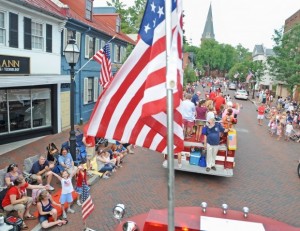 Annapolis elected official, Annapolis Delegate Tony McConkey has represented adjacent communities in the Maryland House of Delegates since 2003. Since redistricting and the 2014 elections, Tony has represented most of the unincorporated portion of the Annapolis zip code of 21409 and will be running for re-election in 21409 in the next state elections in 2018. Tony is currently the Ranking Member of the House Appropriations Committee and the former Vice Chairman of the Anne Arundel Delegation.
Annapolis elected official, Annapolis Delegate Tony McConkey has represented adjacent communities in the Maryland House of Delegates since 2003. Since redistricting and the 2014 elections, Tony has represented most of the unincorporated portion of the Annapolis zip code of 21409 and will be running for re-election in 21409 in the next state elections in 2018. Tony is currently the Ranking Member of the House Appropriations Committee and the former Vice Chairman of the Anne Arundel Delegation.
Cape St Claire Strawberry Festival
Eastport A Rockin’
Annapolis 4th Of July Parade & Fireworks
Annapolis Irish Festival
Maryland Seafood Festival
Annapolis Midnight Christmas Shopping
Annapolis Churches
Broadneck Baptist Church
Mariners Church
St Andrew By The Bay Catholic Church
St Margarets Episcopal Church
Annapolis Post Office
21409
Annapolis Schools
Broadneck High School
Cape St Claire Elementary School
Harbour School
St Andrew By The Bay Preschool
Windsor Farm Elementary School
Annapolis History
Early settlement
Before white settlers arrived in Maryland, the Algonquin and other Native American tribes occupied the region. By the time Annapolis was settled in 1649, the Algonquins were gone from the area, forced out by raiding parties of the Susquehannock tribe.
The original white settlement of the area near Annapolis was at Greenbury Point, although the land is now mostly covered by the Severn River. In the middle of the seventeenth century, Puritans living in Virginia were threatened with severe punishments by the Anglican Royal Governor if they did not conform to the worship of the Anglican church. Then Cecil Calvert, the second Lord Baltimore, offered the Pilgrims generous land grants, freedom of worship, and trading privileges if they agreed to move to Maryland, which he wanted to have settled. In 1649 they started a community on a site at the mouth of the Severn River on the western shore of Chesapeake Bay.
The Puritans named their new settlement Providence. In 1650, Lord Baltimore, the overseer of the colony, granted a charter to the county that surrounded Providence. He named it Anne Arundel County after his beloved wife, Anne Arundel, who had died shortly before at the age of thirty-four. But the Puritans refused to sign an oath of allegiance to Lord Baltimore, in part because he was a Roman Catholic. In 1655 he sent the St. Mary’s militia, headed by Governor William Stone, to force the Puritans into submission. A battle between the two groups took place on March 25, 1655. The Puritans won the conflict, which was the first battle between Englishmen on the North American continent. Eventually, Maryland became a royal colony. The capital was moved further north in 1694 to the site of present-day Annapolis. By that time, for reasons unknown, the Puritan settlement of Providence had all but disappeared.
Development of Annapolis
Over time a small community began to develop on the peninsula that is the site of present-day Annapolis. It was known as Anne Arundel Town, taking its name from the county. The settlement grew and by the late 1600s the population of the province had reached nearly 25,000 residents. People started to object that the then-capital, St. Mary’s, was too far away from where the majority of the people lived.
Royal Governor Francis Nicholson decided a more centrally located capital was needed and chose the site of what is now Annapolis. He named the new capital Annapolis in honor of Princess Anne, who became queen of England in 1702. It was Nicholson who determined that the city be built on a grand baroque street plan much like the great capitals of Europe. Streets were designed to radiate from a circle that was to contain the capitol. In a second circle was built an Anglican church. Residential areas were built for the prosperous families, for artisans, and for working men and their families. In 1696, Nicholson granted a charter to King William’s School, which was built in Annapolis’s center.
During the second half of the seventeenth century, the people of colonial Anne Arundel County had violent encounters with the Algonquins and other tribes along the shores of the Magothy River. The Indians staged raids there to try to protect their tribe and their lands from colonists, who often used devious methods to take advantage of them. Eventually the colonists won out.
Annapolis Prospers
In time Annapolis became the political, social, cultural, and economic hub of Maryland. The city gained its charter in 1708. Annapolis and Anne Arundel County continued to grow into a major shipping port. By the last third of the 1700s, the only town in Maryland to rival Annapolis as a shipping center was Baltimore.
Those were prosperous times for some. With the help of the fertile soil and a slave economy, plantation owners and wealthier citizens were able to furnish their houses with luxury items from Europe. Young ladies and gentlemen wore elegant clothing and attended fancy balls at various large homes.
During the years shortly before the start of the Revolutionary War, and even during wartime, citizens of Annapolis enjoyed racing, dancing, and gambling. Luckily for Annapolitans, the Revolutionary War and the wars of the nineteenth century bypassed the area. During the war’s later years, French volunteer Marquis de Lafayette helped enliven the city’s social scene.
Site of Annapolis Convention
From 1783 to August 1784, Annapolis served as the United State’s first peacetime national capital. There in 1783 General George Washington resigned from the Continental Army. The next year, the Treaty of Paris ending the American Revolution was ratified there. In 1786 the city served as the seat of the Annapolis Convention, at which delegates from five states met to discuss proposed changes to the Articles of Confederation by which the country was then run.
From Post-Revolution to Civil War Times
After the Revolutionary War, Baltimore forged ahead of Annapolis as a center of commerce. However, in 1808, Fort Severn was built on Windmill Point to prevent the British from attacking Annapolis during the War of 1812. (Soldiers inhabited the fort until 1845. Then the post was transferred to the U.S. Navy, becoming the U.S. Naval Academy in 1850.)
As early as 1800 Annapolis had developed into a city of stately residences and public buildings patterned on those in London, England. Members of local high society enjoyed such diversions as fox hunts and racing meets. During the Civil War years most Annapolitans sympathized with the South but did not engage in acts of violence. At that time, facilities at the Naval Academy and St. John’s College were used to house injured soldiers.
Agriculture and Tourism
Until well into the nineteenth century, Anne Arundel County remained agrarian, with tobacco the main crop. Other important crops were wheat, corn, and fruit. Seafoods such as oysters and crab were also a mainstay of the local diet. The addition of steamboats to the local scene after the Civil War brought many visitors to the area, as vacationers fled to the shore to leave behind the heat of the larger cities. This prompted the growth of resorts, beaches, yacht clubs, and summer communities.
In the 1880s the railroad brought a period of development in the area. By 1890 the population of the city had reached 7,604 people. Crops were shipped to markets in Washington, D.C., Philadelphia, and beyond.
The City in the Twentieth Century
During the twentieth century, the area continued to develop, due to such factors as the growth of the state government, the presence of U.S. Navy and Coast Guard facilities, the completion of a bridge to the Delmarva peninsula, and the development of Baltimore-Washington International Airport. The population grew from 7,657 people in 1900 to 10,047 people by 1950.
Today, Annapolis remains a thriving naval and government center. It has enjoyed the benefits of having its own developing local high-tech firms, while also serving as a commuter community for nearby Washington, D.C. and Baltimore.

